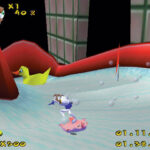Even for an old-school games collector like me, there are corners I don’t always reach, and MegaRace 3 is a game I was completely unaware of. I first encountered MegaRace 1 around the time I experienced true CD games for the first time—those that actually took up more than 100-200 megabytes. The graphics were indeed amazing, but any attempt to play for more than five minutes led to the conclusion that the connection between pressing buttons on the keyboard and what happened in the game was purely coincidental. MegaRace 1 managed to be the only racing game in history to simulate a new kind of pedal: the “gas-brake” pedal. Either your car accelerated uncontrollably, or it slammed the brakes from hell. The weapon system was extremely basic and didn’t add much to the overall experience, which remained painfully simplistic. Add to that the psychedelic colors and embarrassing video clips, and you have a prime example of a game that sold purely because it was those new and exiting CD Format.
MegaRace 2, on the other hand, was an entirely different story. Not only were the graphics, music, and even the video clips dramatically improved (thanks to the beauty queen “Lucinda”), but the gameplay became far more sophisticated, with much better controls, more varied missions, and a proper upgrade system. In fact, it’s likely that if an HD remastered version were released, it could still compete with many modern games simply because its atmosphere was and remains something exceptional.
But, just like many games and movies, after a rise, there must come a fall, and MegaRace 3 takes several steps back. Normally, non-pre-rendered backgrounds are supposed to look better, but the game’s graphics engine—which might have looked impressive on a PS1—seems outdated and blurry. The decision to go with spaceships instead of vehicles makes MegaRace 3 the least original game in the series, as it feels far too much like Wipeout. The high-quality video clips and music were also cut: Lance Boyle (the host) comes across as lethargic and more cynical ([slang term]: “annoying”), with a terrible spiked haircut and a set design reminiscent of the most colorful episode of a kids’ show. The music consists of repetitive five-second segments, creating highly unnatural transitions (and according to the trailer, this wasn’t a technical issue). Usually, quality is said to matter more than quantity, but in this case, the reduced game size (two discs down to one) cannot be overlooked.
All these issues wouldn’t necessarily ruin the game’s core—its gameplay—but in this regard, MR3 also fails miserably! Instead of focusing on one main element, the developers decided to combine shooting, defense, and speed mechanics. Each element is called a “mode,” and players can switch between modes as long as there’s enough energy. On paper, this sounds nice, but in practice, only the training mode makes proper use of the weapon mode, as there’s no other game mode where destroying opponents is necessary. Additionally, there are independent bonuses unrelated to the modes, which are used in the order they’re obtained. Unfortunately, their icons are unclear, and they usually cause random effects to appear behind the vehicle—out of sight! If that’s not confusing enough, there are multiple ways to activate the modes. In short, the game is so convoluted that reading the manual is a must, even though it’s supposed to be a simple racing game, not a simulator.
As mentioned, there are several uninspired game modes. The arcade mode is just a race to finish in the top spots, but for some reason, attempts are limited to three without saving. While each track has a fixed structure that can be memorized, the speed mode—which is nearly essential to win—is a double-edged sword : “high-risk, high-reward”: when activated, it’s almost impossible to avoid mines, and because the vehicle moves so fast, you can’t see them in time. On the other hand, without it, reaching the top spots is very challenging. The fact that you can also lose energy just by bumping into walls makes the arcade mode even more frustrating. All of this is a shame, because some of the tracks are genuinely unique, featuring jumps, twists, and holes reminiscent of the legendary STUNTS (4D Driving).
The arcade mode may be frustrating, but it’s not as bad as the catastrophe mode. This mode tries to take the gameplay in a different direction but ends up doing more harm than good—it introduces various hazards along the track due to absurd biological experiments, and the goal is to survive until the end. I didn’t get far in this mode, as the first track consists of narrow channels, rolling boulders, and giant plants that are nearly impossible to avoid. Very quickly, your only objective becomes collecting as much energy as possible for the defense mode, and even then, it’s almost impossible. I didn’t delve much into the career mode, but it seems similar to the arcade mode.
It’s now easier to understand why almost no one has heard of MR3 when it was first released. The developer, Cryo, chose to use the brand to mimic other games rather than embracing the uniqueness of the series (or at least MR2). It’s tough to say this, but in an era where anyone can download the excellent TrackMania, MR3 isn’t worth even the three dollars it costs. It’s still a bad deal…. On the other hand, the bundle containing its two predecessors is worth much more—even when not on sale.


